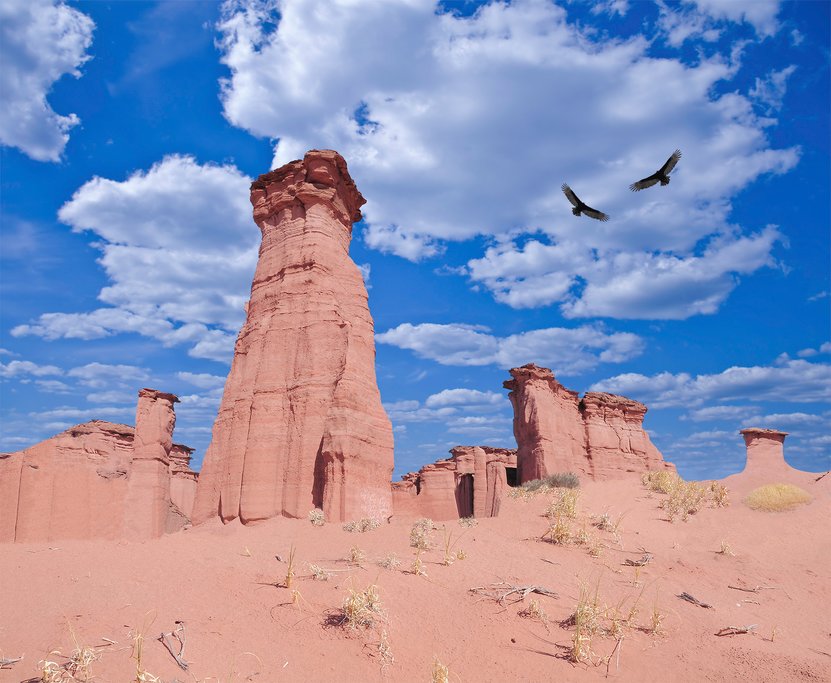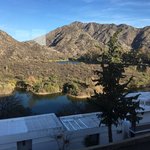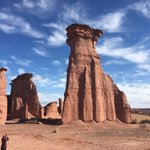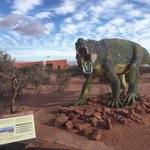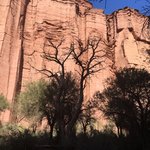Discover Argentina's Secrets
Getting off the beaten path in Argentina is reasonably straightforward, particularly if you have plenty of time and your own wheels. Argentina has a remarkable range of natural wonders and quirky cultural attractions to explore, a number of which can be easily accessed from the main tourist hotspots, by tour or by public transport, while others require substantial detours.
Road trips in Argentina can involve long journeys on roads of varying quality and often without phone signal in between towns; let someone know where you are headed before you set off in case of a breakdown. Some remote destinations require a 4WD vehicle.
Visit the Salinas Grandes

Bolivia has the Salar de Uyuni, Chile has the Salar de Atacama, and Argentina has the less well-known, but no less spectacular Salinas Grandes.
There are two main areas of salt flats: one is at the foot of the Sierras de Córdoba mountain range, near the city of Córdoba, while the other is at the very north of Argentina, near the borders with Chile and Bolivia. Imagine a seemingly never-ending expanse of blinding white crust stretching towards the horizon. Together with a vivid blue sky, it creates a visual effect similar to the one experienced in Uyuni and Atacama - a distortion of perspective that photographers can have a lot of fun with.
To visit Córdoba's Salinas Grandes you need your own wheels: the salt flat lies off RN 157, en route to Tucumán, roughly halfway between the two cities. There are day tours to Argentina's northernmost Salinas Grandes both from Purmamarca in Jujuy and Salta; Purmamarca is a lot closer.
Salt is harvested in both sets of salt flats. Near the visitor centers, you can see square basins cut in the salt crust, filled with turquoise water, as well as buildings made of salt bricks and decorated with salt furniture. You can purchase small carvings made of salt from local artisans.
Expert tip: Don't forget your sunglasses and high-SPF sunscreen when visiting the salt flats!
Commune with Penguins at Cabo Vírgenes

Imagine Argentina's Punta Tombo, but without the infrastructure and the people. The country's second-largest Magellanic penguin colony, located on the tip of the namesake cape, is reachable via a slow, 83-mile ride along a lonely gravel road from Río Gallegos, an oil town in southern Patagonia.
Between September and March, around a quarter of a million Magellanic penguins nests here, digging their burrows in the soil near the sea. From December onwards you're likely to spot penguin chics. You're likely to have the site all to yourself. Get in touch in advance with the Fenton family at the nearby 19th century Estancia Monte Dinero to arrange a meal or a place to stay overnight.
Count Prehistoric Handprints at Cueva de las Manos

Some of Argentina's most spectacular rock art is found in a cave in the Santa Cruz province, some 101 miles south of the town of Perito Moreno, off the RN 40. It's either a long day trip from Perito Moreno or wonderfully worthwhile detour if you're doing a road trip along Argentina's remote and challenging Ruta 40.
Gravel access roads lead from Ruta 40 to the caves; drive slowly and watch out for guanacos crossing the road. At the cave itself, a guided tour takes in 800 or so rock paintings. Most of them are imprints of human hands (particularly left hands), though you may also spot puma paw prints, rhea footprints and a print of a hand with six fingers. If you want to explore the red rock formations of the surrounding Cañon del Río Pinturas, it's worth staying overnight at the basic Estancia Casa de Piedra, some 18 km from the cave.
Attend a Fiesta in Remote Iruya

Clinging to the slopes of arid, ochre-colored mountains, the tiny 17th-century village of Iruya has an end-of-the-world feel to it. The village is nestled at a height of 9120 ft at the confluence of two rivers in the far north of Argentina's Salta province, less than 50 miles from the Bolivian border.
Inaccessible during the summer flash floods, Iruya is reachable the rest of the year via a scenic, dusty, four-hour bus ride through canyons and up and down mountain passes from Humahuaca, Jujuy. The main attraction of the town is the relaxed vibe, the friendly locals, hiking trails and the spectacular mountain vistas.
If you can pick a time to visit, we recommend the first weekend in October when the community celebrates the Fiesta de Nuestra Señora del Rosario, involving masked processions and sacred dance. Before the fiesta, a lively market is set up and hundreds of indigenous Kolla people descend on the village from their mountain hamlets.
See the Sandstone Towers of Talampaya

The lightly-visited canyons and otherworldly rock formations of Parque Nacional Talampaya were once at the bottom of the ocean and the pinnacles and sculpted red walls were shaped by water erosion.
Highlights include the Cañón de Talampaya, fringed by sandstone cliffs and rich with desert life: you can spot guanacos and rheas grazing among the algarrobo trees, while condors soar overhead. You can test the echo at Chimenea by bouncing your voice off the walls, and if you squint, one of the more famous rock formations really does resemble El Monje, a monk.
Entry to the park is by guided visit only, mostly conducted in a minibus with little walking in the fierce sun. It's possible to arrange visits to another part of the park, where you can see the even more spectacular rock formations of Ciudad Perdida and Cañón Arco Iris, and for a particularly eerie experience, it's well worth signing up for a night excursion (conducted when there's a full moon).
Expert tip: It's possible to get to the park via public transport from La Rioja (around three hours one way), though if you sign up for a tour in La Rioja, you can combine a visit to Parque Nacional Talampaya with an excursion to the fossil-rich Parque Provincial Ischigualasto nearby - further evidence that this arid land was once underwater.
Hunt for Dinosaur Remains Around Neuquén

To experience some of the most important paleontological sites in the country, you'll need to make a few twists and turns off the main highways — most of the action occurs around Neuquén, a busy city in central Argentina.
To see the reconstructed skeleton of the second-largest creature ever to have walked the earth — the Argentinosaurus huinculensis — drive or take a bus to Museo Municipal Carmen Funes in Plaza Huincul, 72 miles west of Neuquén. If you're driving between Neuquén and Bariloche, Museo Paleontológico Municipal Ernesto Bachmann in Villa El Chocón makes a great detour off RN 237, 52 miles southwest of Neuquén. It proudly features the largest carnivorous dinosaur ever to have existed — the Gigantosaurus Carolinii — that dwarfs the Tyrannosaurus rex; the fossil was found in 1993 by a local fossil hunter.
On the outskirts of Villa El Chocón, in the Parque Cretacico, you can compare the size of your footsteps to that of Iguanadon prints. Finally, if you have a particular passion for dinosaurs, consider contacting Proyecto Dino, located near the shore of Lago Barreales, 56 miles north of Neuquén. You can arrange to stay on-site and take part in the ongoing excavations of dinosaur remains, supervised by renowned paleontologist Jorge Calvo.
Meet Capybaras in Reserva Provincial Esteros de Iberá

The delicate ecosystem at Esteros de Iberá, an 8077 sq mile wetland expanse in the Corrientes province, near the border with Paraguay, is one of the best places in South America for wildlife-spotting. The vast swampland, with its lakes and shallow lagoons dotted with embalsados (floating islands), is home to a stunning array of creatures, from caymans, giant anteaters, jaguars and capybaras to howler monkeys, swamp deer, otters, maned wolves, bats and around 300 bird species.
Esteros de Iberá is a conservation project run by an ecological foundation set up by US-entrepreneurs-turned-conservationists Kris and Doug Tompkins, who purchased and restored large tracts of private land, repopulating it with native wildlife. The main gateway to the reserve is the soporific village of Colonia Pellegrini, reachable by regular car outside the rainy season, and by 4WD transfers from Mercedes, some 80 miles away.
Lodges in the village arrange boat trips, horseback riding excursions and guided walks in the reserve; night walks are particularly worthwhile. And remember—bring plenty of insect repellent.
Trek in the Untouched Perito Moreno National Park

Autumn in Perito Moreno National Park
Chat with a local specialist who can help organize your trip.
Not to be confused with the glacier of the same name in the popular Parque Nacional Los Glaciares further south, this wild, 714-sq-mile national park nestles by the Chilean border, reachable by 4WD via a rough, lonely side road from the Ruta 40.
Snow-capped, sentinel-like peaks of the Sierra Colorada watch over the park's turquoise lakes, steppe and lenga and coihue forests: all of this is swept over by the relentless wind known as the 'escoba de Dios' (God's broom). There is very little here in the way of infrastructure, so you must bring all supplies with you, including a good tent.
You can pitch a tent at one of the three free campgrounds, or stay at the Estancia La Oriental, a ranch that can arrange horseback riding into the park's backcountry. Some of the best day hikes are from the ranger station to Lago Burgmeister and from the ranch to the summit of 4700 ft Cerro León.
